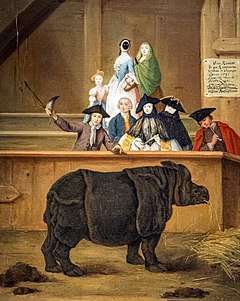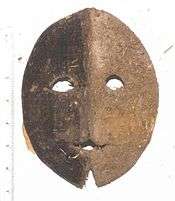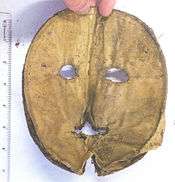Visard
A visard (also spelled vizard) is an oval mask of black velvet, worn by travelling women in the 16th century to protect their skin from sunburn.[1] It was not held to the head by a fastening, but rather the wearer would clasp a bead attached to the interior of the mask between their teeth. The fashion of the period for wealthy women was to keep their skin pale, because a tan suggested that the bearer worked outside and was hence poor.[2]



The practice did not meet universal approval, as evidenced in this excerpt from a contemporary polemic:
When they use to ride abroad, they have visors made of velvet... wherewith they cover all their faces, having holes made in them against their eyes, whereout they look so that if a man that knew not their guise before, should chance to meet one of them he would think he met a monster or a devil: for face he can see none, but two broad holes against her eyes, with glasses in them.
— Phillip Stubbes, Anatomy of Abuses (1583)
In Venice, the visard developed into a design without a mouth hole, the moretta, and was gripped with a button between the teeth rather than a bead. The mask's prevention of speech was deliberate, intended to heighten the mystery of a masked woman even further.[4]
Citations
References
- Elgin, Kathy (2005). Elizabethan England. Infobase Publishing. p. 38.CS1 maint: ref=harv (link)
- Holme, Randal (1688). The Academie of Armorie.
A mask [is] a thing that in former times Gentlewomen used to put over their Faces when they travel to keep them from Sun burning... the Visard Mask, which covers the whole face, having holes for the eyes, a case for the nose, and a slit for the mouth, and to speak through; this kind of Mask is taken off and put in a moment of time, being only held in the Teeth by means of a round bead fastened on the inside over against the mouth.
CS1 maint: ref=harv (link) - "Mask". Portable Antiquities Scheme. 2010.
- Steward, James Christen; Knox, George (1996). The mask of Venice: masking, theater & identity in the art of Tiepolo & his time. Berkeley Art Museum and Pacific Film Archive.CS1 maint: ref=harv (link)
External links
- Details of a visard in the collection of the Norwich Castle Museum
- A miniature visard made for a 17th-century child's doll in the collection of the Victoria and Albert Museum

